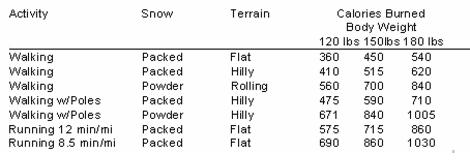Hiking is a fantastic way to enjoy the outdoors, improve your fitness, and explore stunning landscapes․ Adding snow to the mix significantly increases the challenge, transforming a regular hike into a demanding physical activity․ But how many calories can you expect to burn when trekking through a winter wonderland? The answer depends on a variety of factors, including your weight, the terrain, the depth of the snow, and the weight of your pack․ Let’s delve into the details and uncover the secrets of calorie expenditure while hiking in snow․
Factors Influencing Calorie Burn During Snow Hiking
Several elements play a crucial role in determining how many calories you’ll burn while hiking in the snow․ Understanding these factors can help you estimate your energy expenditure more accurately․
- Body Weight: Heavier individuals naturally burn more calories than lighter individuals for the same activity․
- Terrain: Hiking uphill burns significantly more calories than hiking on flat terrain․ Steeper slopes and uneven surfaces increase the effort required․
- Snow Depth: Wading through deep snow requires considerably more energy than walking on packed snow․
- Pack Weight: Carrying a heavy backpack increases the overall workload and calorie burn․
- Hiking Speed: A faster pace will generally lead to a higher calorie expenditure․
- Individual Metabolism: Each person’s metabolism is unique, impacting how efficiently they burn calories․
Estimating Calorie Burn
While it’s impossible to provide an exact number without sophisticated tracking equipment, we can offer some general estimates․ A person weighing 150 pounds might burn around 400-600 calories per hour hiking on relatively flat terrain with light snow․ However, this number can easily double or even triple when hiking uphill in deep snow with a heavy pack․ A more accurate estimate can be achieved using online calorie calculators that factor in activity type, weight, and duration․
Factoid: Did you know that hiking in deep snow can engage more muscle groups than regular hiking, leading to a more comprehensive workout?
Benefits of Hiking in Snow
Despite the increased difficulty, hiking in snow offers numerous benefits beyond calorie burning․
- Improved Cardiovascular Health: Hiking in snow provides an excellent cardiovascular workout, strengthening your heart and lungs․
- Increased Strength and Endurance: The added resistance of snow builds strength and endurance in your legs, core, and upper body․
- Mental Well-being: Spending time in nature, especially in a serene snowy environment, can reduce stress and improve your mood․
- Unique Scenery: Snow-covered landscapes offer breathtaking views and a sense of tranquility․
Safety Precautions for Snow Hiking
Safety is paramount when hiking in the snow․ Proper preparation and awareness are crucial to prevent accidents and ensure a safe and enjoyable experience․
- Check the Weather Forecast: Be aware of potential hazards such as blizzards, avalanches, and extreme cold․
- Dress in Layers: Wear moisture-wicking base layers, insulating mid-layers, and a waterproof and windproof outer layer․
- Bring Appropriate Gear: Carry essentials such as a map, compass, GPS, first-aid kit, extra food and water, a headlamp, and trekking poles․
- Inform Someone of Your Plans: Let someone know your route and expected return time․
- Be Aware of Avalanche Terrain: Avoid hiking in areas prone to avalanches, especially after heavy snowfall․
FAQ About Calorie Burn and Snow Hiking How does snow depth affect calorie burn?
Deeper snow requires more effort to lift your legs and move forward, significantly increasing calorie expenditure․
Does the type of snow (powder vs․ packed) matter?
Yes, powder snow offers greater resistance and requires more energy to navigate than packed snow․
What is the best way to track calorie burn while hiking in snow?
Using a fitness tracker with GPS and heart rate monitoring capabilities is the most accurate way to track calorie burn․
Are there any foods that can help fuel a snow hike?
High-energy foods like nuts, dried fruit, energy bars, and trail mix are excellent choices for fueling a snow hike․
How can I prepare my body for snow hiking?
Regular exercise, including strength training and cardiovascular workouts, can help prepare your body for the demands of snow hiking․

